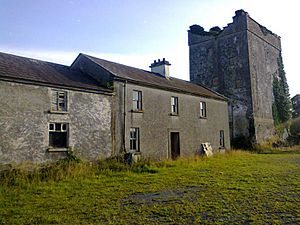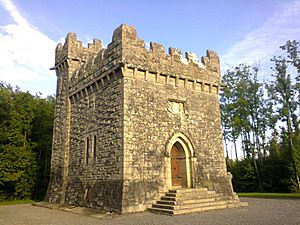Monivea Castle facts for kids
Quick facts for kids Monivea Castle |
|
|---|---|
| Monivea, County Galway, Ireland | |

Monivea Castle with the original Anglo-Norman tower house to the right. The later mansion was built up against its north, west and south walls
|
|
| Coordinates | 53°22′00″N 8°41′00″W / 53.36667°N 8.683333°W |
| Type | Tower house |
| Site information | |
| Open to the public |
Yes |
| Site history | |
| Materials | Stone |
| Events | Commemorative Mass in Mausoleum, 22 April, annually (anniversary of Robert Percy's death) |
Monivea Castle (Irish: Caisleán Mhuine Mheá) is an old castle near Monivea in County Galway, Ireland. It started as a strong stone house built by the O'Kelly family. Later, a powerful family called the ffrench family took it over. They were one of the famous fourteen Tribes of Galway. The ffrench family made the castle even bigger and stronger, adding more buildings and improving the land around it.
In 1876, Monivea Castle was huge, covering over 10,000 acres! This land included the old tower house, the main castle, the special ffrench Mausoleum, and the beautiful Monivea Woods. The land right around the castle was used to grow food and resources for the castle owners. Other parts of the land were rented out to farmers. Many people lived and worked on the estate, and this is how the nearby town of Monivea began to grow.
Contents
Exploring Monivea Castle and Its Grounds
The Castle Building
Monivea Castle is hidden deep inside a large forest. A stone fence and five rows of giant beech trees surround it, making it feel like a secret place. The castle also has two small gate-lodges. These were used by staff to check who was coming to visit, or to welcome guests.
The ffrench Mausoleum
Deep in Monivea Wood, you'll find the ffrench Mausoleum and a small chapel. It was built to honor Robert Percy ffrench, who had passed away. In 1914, the Pope even allowed special church services to be held there sometimes.
The mausoleum was designed by an architect named Francis Persse. It took four years to build and cost a lot of money! It looks like a small castle, about 25 feet wide and 30 feet tall. It has cool crenellation (like the battlements on a castle wall) along the roof and a small tower on the left side. Stone steps lead up to a fancy archway and a heavy oak door with decorative metal hinges.
Inside the ffrench Mausoleum, the only light comes from beautiful stained glass windows. This makes the place feel very peaceful. There's no electricity inside. A main window shows the Resurrection, and it's placed behind a black and white marble altar. Other windows on the sides show twelve of the fourteen Tribes of Galway. These amazing windows were made by a famous German company called Franz Mayer & Co. in Munich. They were known for making stained glass for many churches, including St. Peter's Basilica in Rome.
Two large granite pillars stand at the entrance to the main area, and four black marble pillars help hold up the roof. The mausoleum has a high, arched ceiling and granite arches. Inside, you'll see a life-size statue of Robert Percy ffrench made from white marble. A sculptor from Italy named Francesco Jerace made it look just like him. The statue shows him lying down, covered by a beautifully carved marble cloth with a Maltese cross on it. A message carved on the side of the statue says: "He will be forgiven much because he has loved much."
Monivea Woods: A Natural Wonderland
Monivea Woods is about 17 miles east of Galway city, near Athenry. This area used to be mostly bogland, which is wet, spongy ground. But over many years, the ffrench family worked hard to turn it into useful land. They added lime and other natural materials to the soil, which helped plants and trees grow and made the ground stronger. Robert Percy ffrench kept adding more land and planted many beech trees, creating the large parkland you see today.
Monivea Woods became a home for lots of wildlife, like foxes, hares, squirrels, and birds that migrate (travel for seasons). It was also a popular spot for hunting events. Kathleen, who inherited Monivea Castle from her father Robert ffrench, loved these events and enjoyed walking and relaxing in the peaceful woods.
Today, Monivea Woods is special because of its unique plants (flora) and ancient discoveries (archaeology). The broadleaf forest is a natural home for Irish wild fungi, lichens, bryophytes, and native plants. The trees are perfect places for birds like Wood Pigeons, Sparrowhawks, and Jays to build nests and sing. Smaller bushes provide shelter for tiny animals. Plants that produce seeds and forest insects offer an easy food source for many creatures. Monivea Woods is now considered one of the most important and sensitive natural areas in East County Galway.
A report from 2002 said that only 9% of Ireland has any forest cover today, and less than 1% of the island has forests that are older than 1600. This makes Monivea Woods not just an amazing achievement in land care, but also a very important place for helping Ireland's natural variety of life continue to grow.
Images for kids




